

Futures
Prices are published for every trading session.
Futures prices are reported daily in major newspapers such as The Wall Street Journal. Following is a brief explanation to help you decipher these listings. Section 2 of The Wall Street Journal contains futures price and volume quotes from the previous trading session. Contracts are grouped into like commodities such as Food and Fiber, Metals and Petroleum, Financial and Livestock and Meat.
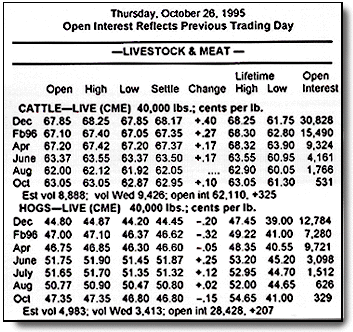
Futures Stats
In parentheses, and adjacent to the name of the contract, is the abbreviation of the exchange on which the contract is traded. Each of the contracts shown in The Wall Street Journal listing on the previous page are traded at the CME (Chicago Mercantile Exchange). Let's use the Live Cattle listing as an example. Just to the right of the exchange abbreviation (CME) is the contract size and the cost per unit. With Live Cattle, a contract represents 40,000 pounds of cattle. The prices quoted are listed as cents per pound (i.e., 67.85 cents per pound).
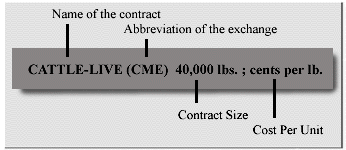
Each contract maturity or delivery month is listed downward along the left margin. In the listing for Live Cattle, the December 1995 contract is listed first because it is the most nearby contract traded. As we go down the margin, we are going out to future months in the 1996 calendar year, eventually ending in October, 1996.
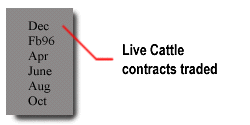
Again, let's look at the Live Cattle quotes, paying attention to the Dec 1995 contract (the first one in the list). The first quote of 67.85 is the Open or opening price for this day's trading. Moving to the right, the next quote we see is the High price of the day for the December 1995 Live Cattle contract, 68.25. Right next to the high is the Low price of the day for trading the December contract, 67.85. As we move along to the right, we next run into the Settle price of 68.17, which is the closing price for this day's trading session. Just next to the settle is the net Change in the closing price from the prior day's trading session. In this case, the net change is + .40.
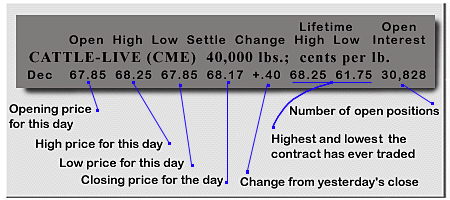
The next two columns indicate the Lifetime High and Lifetime Low for the contract. This indicates a high of 68.25 and a low of 61.75 for the December contract since its inception. The last item is Open Interest, which indicates the number of open positions in that contract. Open interest reads 30,828, meaning there are 30,828 contracts still long and short in the market. Remember, when two people trade one contract (one trader buying from a trader selling), that represents one open interest.
At the bottom of each contract heading (under the quotes for that particular commodity) is another line that provides information detailing:
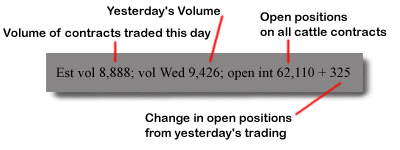
Options
Information on options prices can be found easily in The Wall Street Journal. From the following table, you can find out the previous day's closing prices for all available options, as well as strike prices and expiration months.
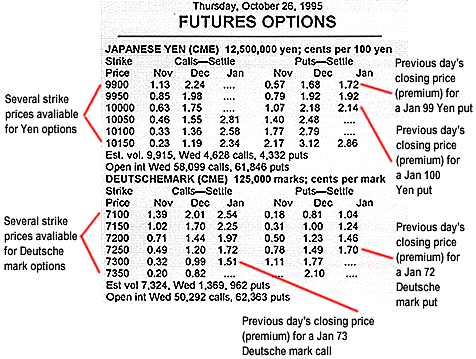
Here, we've highlighted the Deutsche mark Dec 72 call option. On Thursday, October 26, 1995.
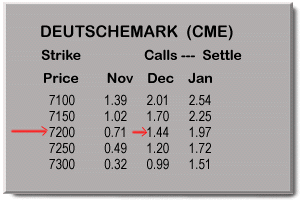
This 72 call option settled or closed at 1.44 cents per mark. The right to go long or buy a Deutsche mark futures contract at a price of 72 between now and December would cost the option buyer a premium of 1.44 cents per mark. That would be $1800 total for the premium (.0144 X 125,000 Deutsche marks).
The buyer of the option pays the $1800 premium to the seller of the option (and pays a commission to the brokerage firm). The seller of the option receives the $1800 premium (but must also pay a commission to the brokerage firm).
If the futures advanced to
73, the option would increase in value because the holder of the
option has the right to buy at a lower price (72) than is currently
trading. (Notice that a Dec 73 call option is worth less than
a Dec 72 call option because the right to buy the 73 call is worth
less than the right to buy lower at 72.) Only if the December
Deutsche mark futures price rises above 72 will the 72 call options
gather any value. If not, then by expiration, the 72 call option
will waste away and eventually expire worthless. However, the
most you could lose would be the premium paid.